
Scrabble is a word game in which two to four players score points by placing tiles, each bearing a single letter, onto a game board divided into a 15×15 grid of squares. The tiles must form words that, in crossword fashion, read left to right in rows or downward in columns and are included in a standard dictionary or lexicon.
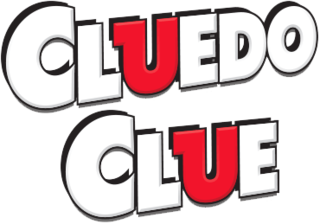
Cluedo, known as Clue in North America, is a murder mystery game for three to six players that was devised in 1943 by British board game designer Anthony E. Pratt. The game was first manufactured by Waddingtons in the United Kingdom in 1949. Since then, it has been relaunched and updated several times, and it is currently owned and published by the American game and toy company Hasbro.

Jenga is a game of physical skill created by British board game designer and author Leslie Scott and marketed by Hasbro. The name comes from the Swahili word "kujenga" which means 'to build or construct'. Players take turns removing one block at a time from a tower constructed of 54 blocks. Each block removed is then placed on top of the tower, creating a progressively more unstable structure. The game ends when the tower falls over.

Candy Land is a simple racing board game created by Eleanor Abbott and published by Milton Bradley in 1948. The game requires no reading and minimal counting skills, making it suitable for young children. No strategy is involved as players are never required to make choices; only following directions is required. About one million copies per year are sold.

Hungry Hungry Hippos is a tabletop game made for 2–4 players, produced by Hasbro, under the brand of its subsidiary, Milton Bradley. The idea for the game was published in 1967 by toy inventor Fred Kroll and it was introduced in 1978. The objective is for each player to collect as many marbles as possible with their toy hippopotamus model. The game was, at one point, marketed under the "Elefun and Friends" banner, along with Elefun, Mouse Trap and Gator Golf.
Operation is a battery-operated game of physical skill that tests players' hand-eye coordination and fine motor skills. The game's prototype was invented in 1964 by University of Illinois industrial-design student John Spinello, who sold his rights to renowned toy designer Marvin Glass for $500 and the promise of a job upon graduation, which was not fulfilled. Initially produced by Milton Bradley in 1965, Operation is currently produced by Hasbro, with an estimated franchise worth $40 million.
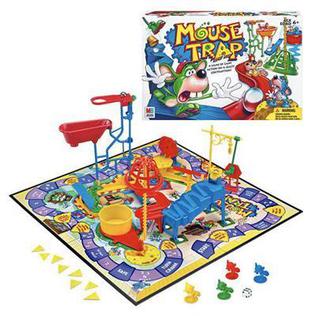
Mouse Trap is a board game first published by Ideal in 1963 for two to four players. It is one of the first mass-produced three-dimensional board games. Players at first cooperate to build a working mouse trap in the style of a Rube Goldberg machine. Then, players turn against each other to trap opponents' mouse-shaped game pieces.

B-Daman is a marble shooting toy franchise produced in Japan by Takara. It was originally based on the Bomberman series, but later expanded into other franchises and its own original designs.
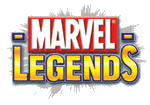
Marvel Legends is an action figure line based on the characters of Marvel Comics, initially produced by Toy Biz, then by Hasbro. This line is in the 6-inch (150 mm) scale, with spin-off lines in the 4-inch (100 mm), 8-inch (200 mm), and 12-inch (300 mm) scale.
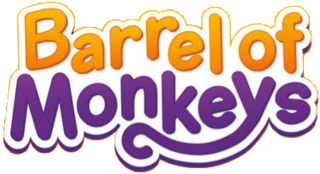
Barrel of Monkeys is a toy game released by Lakeside Toys in 1965. It was created by Leonard Marks and Milton Dinhofer in 1961, and in 1964, Herman Kesler partnered to sell it to Lakeside Toys, which released it in 1965. It was then produced by the Milton Bradley Company, and Hasbro. Milton Bradley's editions consisted of a toy barrel in either blue, yellow, red, purple, orange, gray or green. The barrel contains 13 monkeys but can hold 24, their color usually corresponding to the barrel's color. The instructions state, "Dump monkeys onto table. Pick up one monkey by an arm. Hook other arm through a second monkey's arm. Continue making a chain. Your turn is over when a monkey is dropped." In addition to these basic instructions, the barrel also contains instructions for playing alone or with two or more players.

Batman action figures have been produced since the 1940s. These action figures, inspired by the character's appearance in comics and serials, were created by DC Comics and manufactured by various toy companies. These figures were made of various materials such as wood, tin, and plastic. They were typically between 6 and 8 inches in height and featured movable joints that allowed them to be posed in various positions.

Mall Madness is a shopping themed board game released by Milton Bradley in 1988.
Action Man was a line of action figures produced by Hasbro from 1993 to 2006 and again in 2009.
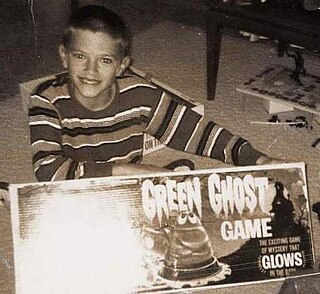
Green Ghost is a board game for up to 4 players, first published in 1965 by Transogram. Green Ghost is the first board game designed to be played in the dark.
Action Jackson is a discontinued line of action figures and accessories manufactured by Mego Corporation in the early 1970s. It is Mego's first action figure series, and was an initial success but then lost sales to Hasbro's G.I. Joe line. It became the template for Mego's popular later lines of 8-inch action figures based on licensed characters from such franchises as DC Comics, Marvel Comics, and Star Trek.

Schaper Toys, or W.H. Schaper Mfg. Co., Inc. as it was originally known, was a game and toy company founded in 1949 by William Herbert Schaper in Robbinsdale, Minnesota. "Herb" Schaper published a variety of games but was best known for having created the children's game, Cootie. In 1971, the company was sold to Kusan, Inc., and began operating as Schaper Toys, a subsidiary of Kusan, Inc. In 1986, Schaper Toys was acquired by Tyco Toys, which sold the rights to Cootie and three other of the company's best-known games to the Milton Bradley Company. These games are still being sold.
Don't Spill the Beans is a children's game for 2 or more players ages 3–6 published by Milton Bradley Company, a subsidiary of Hasbro The game was originally manufactured by Schaper Toys but acquired by Milton Bradley in 1986 through its then owner, Tyco Toys. The game is described by Hasbro as a "Classic Preschool Game. A Favorite For More Than 30 Years!".
G.I. Joe is an American media franchise and a line of action figures owned and produced by the toy company Hasbro. The initial product offering represented four of the branches of the U.S. armed forces with the Action Soldier, Action Sailor, Action Pilot, Action Marine and later on, the Action Nurse. The name is derived from the usage of "G.I. Joe" for the generic U.S. soldier, itself derived from the more general term "G.I.". The development of G.I. Joe led to the coining of the term "action figure". G.I. Joe's appeal to children has made it an American icon among toys.
Toys-to-life is a video game feature using physical figurines or action figures to interact within the game. These toys use a near field communication (NFC), radio frequency identification (RFID), or image recognition data protocol to determine the individual figurine's proximity, and save a player's progress data to a storage medium located within that piece. It was one of the most lucrative branches of the video game industry especially during the late 1990s and 2010s, with the Skylanders franchise alone selling more than $3 billion worth over the course of four years.
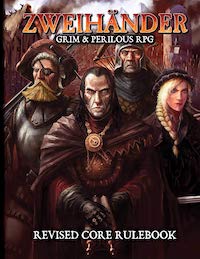
Zweihänder Grim & Perilous RPG or Zweihänder is a 2017 dark fantasy tabletop role-playing game designed by Daniel D. Fox. Zweihänder won two gold ENNIE Awards. Zweihänder was designed for unusually punishing combat.















